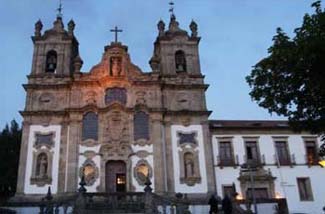
Photos courtesy of Pousada de Guimarães
Convento dos Agostinhos
4810-011 Guimarães
Tel: ++351 253 511 249
Fax: ++351 253 514 459
Official pousada website
Reserve with Booking.com
49 rooms and 2 suites
Double rooms: 110–228 euros
Suite: 154–313 euros
Rates include breakfast, tax,
and service.
Packages and discounts
available.
Open: all year
The pousada is 3 km south of Guimarães in the Penha National Park.
On site: swimming pool
Nearby: golf; horseback
riding; hiking
In a magnificent setting overlooking Guimarães (“the cradle of Portugal”), this pousada ranks as one of the finest in the country.
On one side of the monastery stands a wonderful twin-steepled, stone church; on the other side a newer wing blends with the original architecture.
Inside you’ll find a stunning array of vaulted ceilings, stone pillars, cloisters, azulejos (tilework), terraces, and balconies. Museum quality pieces fill the public rooms.
Long, austere corridors lead to the guestrooms. In the atmospheric, original wing these rooms are installed in the original monks cells, where you have a combination of stone and plasterwork on walls thick enough to hold window seats. More spacious are the rooms in the attached “new” wing.
A stone dining room features regional cuisine. During fine weather, an inner cloister with a beautiful stone fountain in the middle opens up to a bar.
Surrounding the pousada is a formal garden that extends into park woodland.
![]() Gorgeous azulejos dating back to the 18th century.
Gorgeous azulejos dating back to the 18th century.
![]() Won the National Architectural Award in 1985 for its fine restoration work
Won the National Architectural Award in 1985 for its fine restoration work